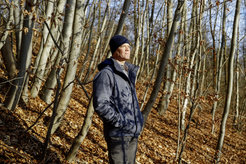"To leave the forest alone is naive"
The German forest is in bad shape. Dead trees and open canopies already in summer clearly show how bad situation really is. Dr. Henrik Hartmann, head of a research group at the Max Planck Institute for Biogeochemistry in Jena, investigates how forest may have to change to survive progressive climate change. In an interview, he reflects on the state and potential future of German forests and how science and politics can facilitate forest adaptation.

Will there still be forests in 30 years from now, or will Germany become a savannah?
Forecasting a few decades into the future is difficult. Forest run on different timescales compared to humans. But if the amount of precipitation doesn’t change, there will still be forests in 150 years from now. The big question is what they will look like. Certainly different from today, even though many people do not want to admit this as it worries them.
In many parts of Germany, however, there has been much less rain in the last few years than the average of the last decades.
True, but that is not the only problem: because the average temperature has consistently increased during the last decades, tree leaves transpire more water. Even if the amount of precipitation remains the same, the soil continues to dry out. At some point, trees then suffer from these drought conditions. This affects in particular large and old trees. The heat waves and droughts in recent years are a good indicator for what is still to come.
However, other species will be able to cope with the conditions in the long run, at least if the climate does not continue to change as rapidly as it has done so far. Forests are very resilient and during the almost 400 million years of their existence, they have survived worse things than human-made climate change. The forests will do just fine without us. For us, however, it will be difficult, if the forest declines in our close environment or even disappears from altogether.
How will forests look like in the future?
This is an open question that we have yet to explore by bringing together experts from very different disciplines: ecologists, eco-physiologists, of which I am one, foresters and modelers who can develop scenarios for the future. That's one reason why I founded the Tree Mortality Network with a few colleagues. In this network, we investigate, for example, which tree species die under which conditions so we can draw conclusions about future forest health and composition.
